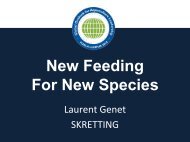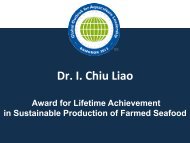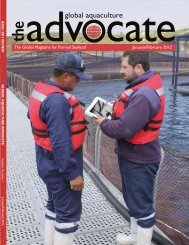May/June 2010 - Global Aquaculture Alliance
May/June 2010 - Global Aquaculture Alliance
May/June 2010 - Global Aquaculture Alliance
Create successful ePaper yourself
Turn your PDF publications into a flip-book with our unique Google optimized e-Paper software.
production<br />
Chile’s Salmon Industry Addresses<br />
Health Crises<br />
New Controls, Regulations Drive Recovery Trend<br />
In combination with new regulations, salmon farmers’ modified production practices<br />
are helping Chile’s aquaculture industry recover.<br />
Summary:<br />
Environmental and fish health<br />
problems have affected Chile’s<br />
salmon farmers since 2004. As<br />
production ramped up, 2006 saw<br />
an increase in sea lice that reduced<br />
output. In 2007, infectious salmon<br />
anemia spread across the farming<br />
region and quickly cut production.<br />
The sea lice are now under<br />
control, and fish biomass has been<br />
decreased. New regulations and<br />
voluntary control measures are promoting<br />
a new production model in<br />
the industry.<br />
After more than two decades of<br />
impressive growth, the Chilean aquaculture<br />
industry is facing a crisis due to the<br />
effects of infectious salmon anemia (ISA)<br />
on its Atlantic salmon, Salmo salar. Since<br />
the second quarter of 2007, ISA has<br />
caused an estimated production drop of<br />
around 50%.<br />
Number of Sites<br />
350<br />
300<br />
250<br />
200<br />
150<br />
100<br />
50<br />
0<br />
Adolfo Alvial<br />
Asesorias S.A<br />
Casilla 1003<br />
Puerto Varas, Chile<br />
adolfoalvial@gmail.com<br />
ISA is just the last in a series of environmental<br />
and fish health problems that<br />
have affected salmon farmers in Chile<br />
since 2004. During that period, biomass<br />
rose, particularly in some coastal areas of<br />
the 10th region, such as east of Chiloé<br />
Island, where around 40% of the total<br />
salmon production concentrated.<br />
The end of 2006 saw an increase in<br />
sea lice, Caligus rogercresseyii, probably<br />
due to a combination of factors, such as<br />
higher water salinity and farm concentration,<br />
and poorer fish health. The parasitic<br />
sea lice spread rapidly through the 10th<br />
region and then the 11th, reaching levels<br />
of infestation that reached 30-50 parasites/fish<br />
in some cases.<br />
Treatment with emamectine benzoate<br />
proved ineffective due to the development<br />
of resistance. Many fish were<br />
stressed, immunologically depressed and<br />
externally injured, which allowed rapid<br />
penetration of opportunistic pathogens.<br />
Q3 2007 Q4 2007 Q1 2008 Q2 2008 Q3 2008 Q4 2008 Q1 2009 Q2 2009<br />
Stocked Sites Sites With ISA<br />
Figure 1. Comparison of salmon site concentration and detection of ISA since 2007<br />
(Atlantic salmon). Source: Author research based on official information.<br />
ISA was confirmed at a central Chiloé<br />
site in July 2007. Since then, the ISA<br />
virus has dispersed in the 10th, 11th<br />
and 12th regions (circled area).<br />
In July 2007, in the middle of the<br />
efforts to control the sea lice, the finding<br />
by Marine Harvest Chile of salmon with<br />
ISA at a central Chiloé site was confirmed<br />
by local and foreign reference laboratories.<br />
Only a few days later, other<br />
sites reported ISA outbreaks, and since<br />
then, the ISA virus has dispersed in the<br />
10th, 11th and 12th regions, despite contingency<br />
measures rapidly enacted by the<br />
government and the voluntary measures<br />
employed by the farm companies.<br />
ISA Study<br />
An epidemiologic study developed<br />
from the beginning of the ISA problem<br />
by Marine Harvest along with the Chilean<br />
lab Biovac and Dr. Fred Kibenge’s<br />
lab on Prince Edward Island recently<br />
showed that the Chilean ISA virus is<br />
genetically unique, although close to a<br />
virus reported in 1996 in Norway. Using<br />
the Backtrack program, it was estimated<br />
that the virus presented in Chile as early<br />
as 1996 (± 2 years) and would exhibit a<br />
strong diversification around 2005.<br />
The virus found in Marine Harvest<br />
Chile’s first reported case in 2007 was not<br />
the oldest strain among the types<br />
detected in Chile. This suggested that the<br />
virus was present in the Chilean environment<br />
for several years at relatively low<br />
prevalence and load, and caused mortalities<br />
that could not be associated with<br />
known diseases.<br />
Effective Controls<br />
At present, the sea lice are under control<br />
due to a successful control plan. Also,<br />
the susceptible fish biomass in the sea has<br />
decreased dramatically (Figure 1). In<br />
addition, a number of new regulations<br />
and voluntary measures require zone<br />
management programs, strict egg import<br />
control, complete biosecurity and other<br />
changes that are promoting a new production<br />
model in the industry. Although<br />
biological improvements are becoming<br />
evident, further regulation and company<br />
investment will be needed.<br />
The crisis will be controlled, and the<br />
production trend started to change during<br />
the second half of 2009. Stocking reactivation<br />
will start in <strong>2010</strong>.<br />
Perspectives<br />
The new industry will have new regulations,<br />
a new enforcement system, new<br />
voluntary measures and, at the end, a new<br />
production model reflecting profound<br />
changes that will allow Chile to again be<br />
an industry leader, not only in quantitative<br />
terms but also qualitative.<br />
Knowledge of the dynamic environment<br />
and its carrying capacity will be fundamental<br />
for the new industry success.<br />
Without these elements, Chile will not be<br />
able to manage its sanitary contingencies<br />
in the long term and will face the risk of<br />
new crises as profound as the present one.<br />
42 <strong>May</strong>/<strong>June</strong> <strong>2010</strong> global aquaculture advocate global aquaculture advocate <strong>May</strong>/<strong>June</strong> <strong>2010</strong> 43





